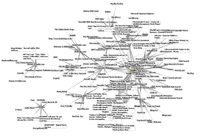Uniform Resource Locator
Uniform Resource Locator (URL) is another name for a web address. URLs are made of letters, numbers and other symbols in a standard form.[1] People use them on computers, to make the computer fetch and show some specific resource (usually a web page) from another computer (web server) on the Internet. They do this by typing the URL into a web browser, or more often clicking a link, for example one on a web page that they are already seeing.

URLs consist of several parts:
- A protocol. Very often, this is the Hypertext Transfer Protocol (HTTP)
- Some separation characters: ://
- The other computer's name or address. It is very common for names to start with www. (which stands for World Wide Web), but the entire name is up to that computer's administrator.
In some cases, the URL may also contain
- The path to a document or script.
- In the case of a script, additional parameters after a question mark (?)
- Username and password needed to access a certain page
- Some text after a pound sign (#), naming a spot to skip ahead to.
The URL of this page is https://simple.wiki.x.io/w/index.php?title=Uniform_Resource_Locator
- https is the protocol
- simple.wiki.x.io is the web site
- /w/index.php is a script. That script gets parameters, title=Uniform_Resource_Locator
A shorter form, called a ("relative") URL, is used when a computer could correctly fill in the full ("absolute") URL from context. For example, of /wiki/URL only works for a link on Wikipedia to this page on Wikipedia. Absolute URLs can be shared outside of computers, even with little or no explanation.
Extensions
changeThese are at the end of the domain name which has a period mark before it. At first there were six main extensions:
- .com - Commercial use
- .net - network / Internet service provider use
- .org - Organizational use
- .edu - Educational use (Schools and universities)
- .mil - Military use
- .gov - Governmental use
Today, there are many other URL extensions. These are usually either a top level domain or interest grouping. Each country has its own top level domain, for example, .ca for Canada, .us for the United States of America or .co.uk for the United Kingdom. Many countries have a government-only extension, for example the United States uses .gov or .fed.us, .gc.ca for Canada and .gov.uk for the United Kingdom. Interest group domains would include .tv (television), .pro (professionals) and .xxx (pornography). These are not used as often as the original extensions.